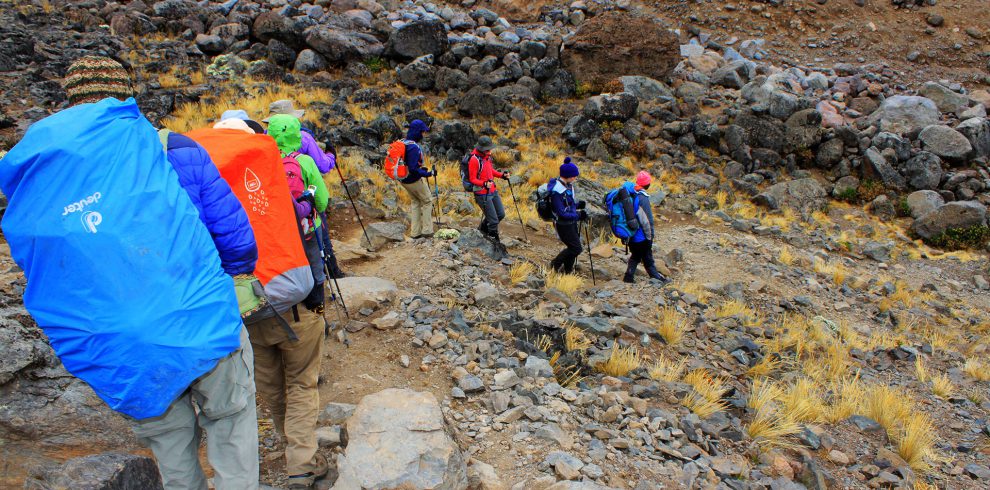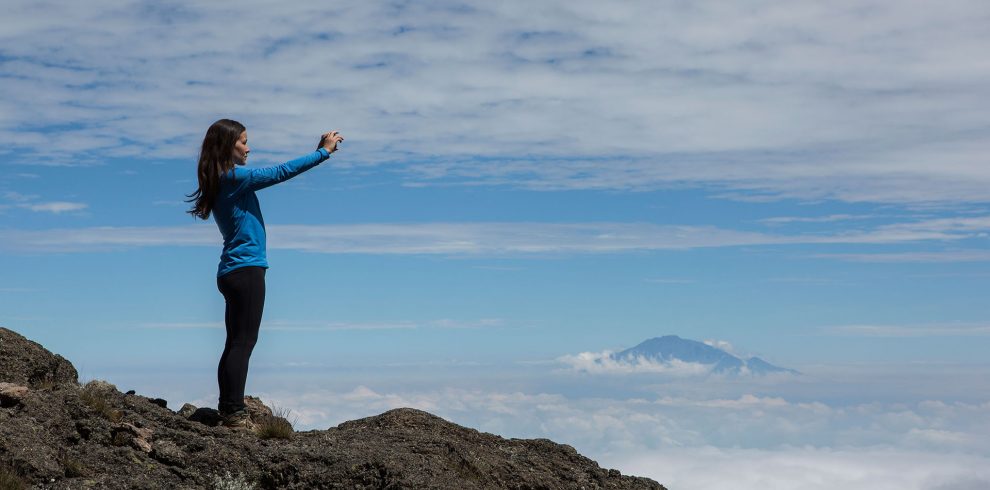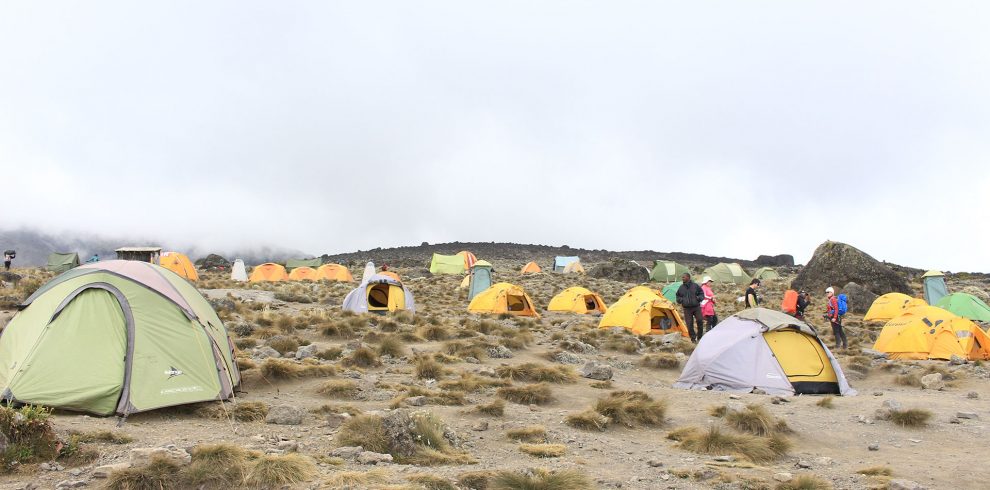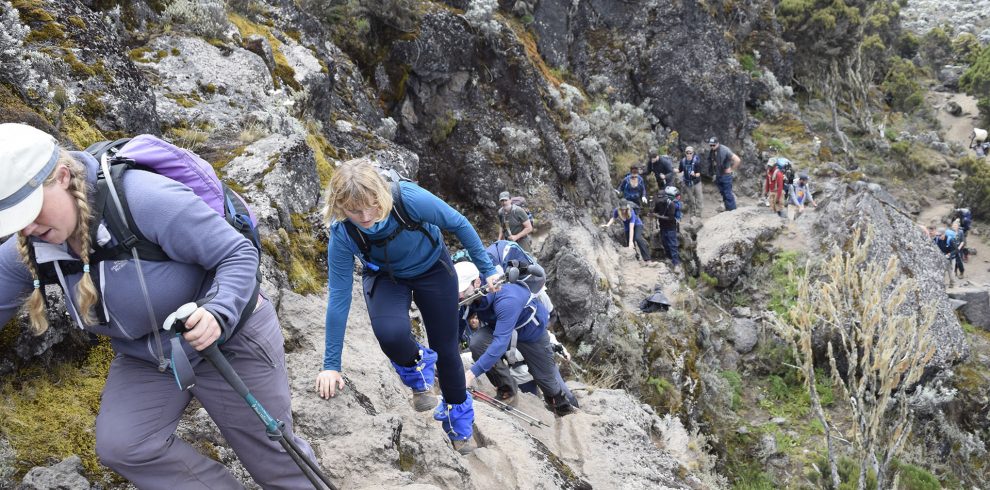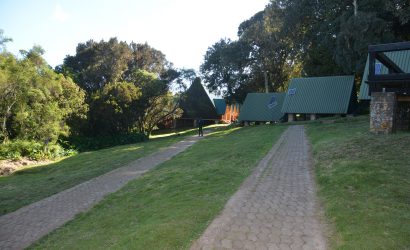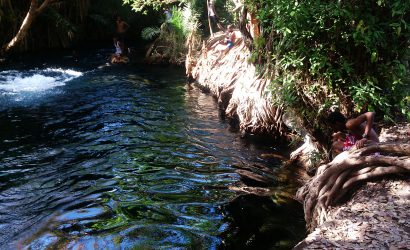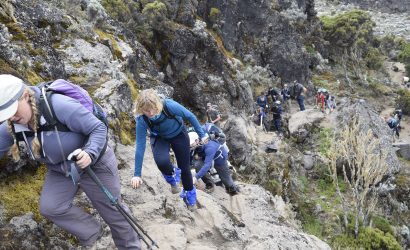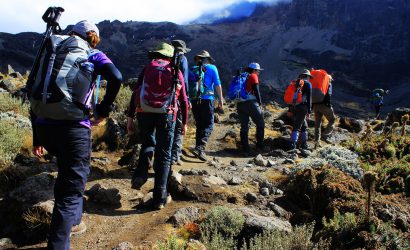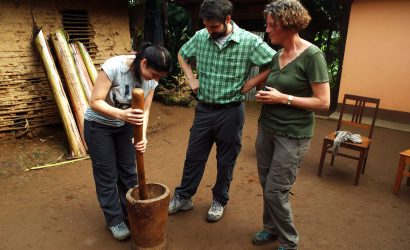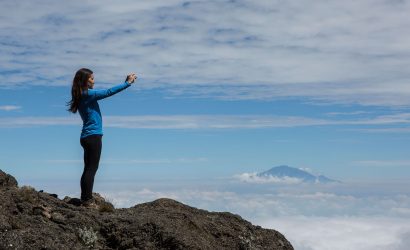Overview
Tp Kilimanjaroleads treks up the unique Rongai Route known to be more scenic than the Marangu Route, easier than the Machame Route, and the success rate on the Rongai is very high. Unlike the Marangu Route where you sleep in huts, on the Rongai you sleep in tents (tents are included), and the porters will pitch your tent for you. Meals are served in a dinner tent or on a blanket outside. The Rongai starts on the north side of the mountain just south of the Kenyan border, and is one of the least traveled routes. The Rongai joins the Marangu for the summit climb, then you descend the Marangu Route on the mountain’s southeast side, so you see Kilimanjaro from many view points. There are two versions of this trek – a direct 6-day itinerary, and a 7-day itinerary that takes a longer route. The more expedient 6-day itinerary is described below and the longer variation is described in the extra days section.
Arrive at the Kilimanjaro International Airport. You will be met at the airport and transferred to the Springlands Hotel or similar hotel in Moshi for your overnight
After breakfast we will transfer you to Rongai. The climb begins from the attractive wooden village of Nale Moru (1,950 m.) on a small path that winds through fields of maize and potatoes before entering pine forest. The track then starts to climb consistently, but gently through attractive forest that shelters a variety of wildlife, including the beautiful Kilimanjaro Colobus monkey. These monkeys are black with a long ‘cape’ of white hair and a flowing white tail. The forest begins to thin out and the first camp is at the edge of the moorland zone(2,600 m.) with extensive views over the Kenyan plains. [3-4 hours walking]
The morning walk is a steady ascent up to the ‘Second Cave’ (3,450 m.) with superb views of Kibo and the Eastern ice fields on the crater rim. After lunch, we leave the main trail and strike out across the moorland on a smaller path towards the jagged peaks of Mawenzi. Our campsite is in a sheltered valley with giant views near Kikelewa Caves (3.600 m.) [6-7 hours walking]
A short but steep climb up grassy slopes is rewarded by superb all around views and a tangible sense of wilderness. We leave vegetation behind shortly before reaching the next camp at Mawenzi Tarn (4,330 m.), spectacularly situated in a cirque directly beneath the towering spires of Mawenzi. The afternoon will be free to rest or explore the surrounding area as an aid to acclimatization. [3-4 hours walking]
We cross the lunar desert of the ‘Saddle’ between Mawenzi and Kibo to reach School campsite (4,750 m.) at the bottom of the Kibo crater wall. The remainder of the day is spent resting in preparation for the final ascent before a very early night! [4-5 hours walking]
We will start the final, and by far the steepest and most demanding, part of the climb by torchlight around 1 a.m. We plod very slowly in the darkness on a switchback trail through loose volcanic scree to reach the crater rim at Gillman’s Point (5,685 m.) We will rest there for a short time to enjoy the spectacular sunrise over Mawenzi. Those who are still feeling strong can make the three hour round trip to Uhuru Peak (5,896 m.), passing close to the spectacular glaciers and ice cliffs that still occupy most of the summit area. The descent to Kibo (4,700 m.) is surprisingly fast and, after some refreshment, we continue the descent to reach our final campsite at Horombo (3,720 m.). [11-15 hours walking]
The Trip Cost Includes
- Transfer to/from Kilimanjaro International Airport
- 2 nights for hotels in Moshi. Before and after climb.
- Transfer to and from park gates
- Park fees for you and all your climb crew
- All government taxes as required
- Services of Siafu Travel porters, guides, cooks
- All meals prepared while on the mountain. Breakfast, Hot lunch/picnic lunch and dinner
- Purified drinking water throughout to keep you hydrated
- All weather Water proof tents
- 2 inches foam mattress
- Dinning tents
- Comfortable portable dining chairs and tables
- Kitchen tent and all equipments for mountain food preparations
- Private toilet tent (Optional)
The Trip Cost Excludes
- International flights fares
- Tanzania entry visa
- Travel Insurance
- Tips for you climb crew
- Laundry services
- Rental gear
Our trekkers’ vital signs, oxygen saturation’s, general health and well-being are monitored, recorded and assessed each day.
Be confident in the knowledge that our guides are medically trained as Wilderness First Respondents ready to respond to any emergency should it arise.
We use only the best equipment to ensure you receive the very highest standard of medical and safety care.
Jaribu has partnered with AMREF Flying Doctors, our medical consultants and evacuation specialists. AMREF Flying Doctors picks up where travel medical insurance leaves off and provides the finest international medical response, emergency evacuation and field rescue should one of our trekkers become injured.
Pulse-oximeter: carried by the head guide as a diagnostic tool and measure of acclimatization
Hyperbaric chamber: a pressure altitude chamber also known as a Gamow bag
AED (Automated External Defibrillator) heart saving device
Oxygen kits: for emergency use only, not to supplement climbing
Medical stretcher: to assist with evacuation should the need ever arise and specifically designed to be used in the event of a helicopter extraction/ evacuation
Comprehensive medical /first aid kits: carried by your guides to assist with any medical emergencies that may arise
Mobile phones: carried by the head guide and all assistant guides, for daily communications with our base in Arusha
VHF 2-way radios: to facilitate communication between the guides
Satellite phone: carried by the head guide for emergencies only.
Our guides have many years experience climbing Kilimanjaro in order to receive their KINAPA National Park license. They are all well trained Wilderness First Responders well capable of assisting you in case of injury or emergency. They are competent in the use of all our medical equipment, oxygen, pressure altitude chamber and stretcher and immediately able to facilitate emergency contact using our Thuraya satellite phone with the Tp Kilimanjarobase in case of an emergency. Guides are trained specifically for both determining when and if an evacuation is necessary and how to properly carry out the evacuation.
The weather on any high altitude mountain can be changeable and unpredictable and Kilimanjaro is no exception. Just because it is the dry season there is no guarantee that you will not see rain! From our experience on Kilimanjaro, the following provides a general outline of annual weather conditions. January to March is warmer with only the occasional brief shower. It is often quieter than the other peak season of June to October which coincides with the main school holidays in Europe and Australia. April and May are the rainy months and generally avoided though trekkers will find greatly reduced traffic on all routes. During these months we generally undertake Kilimanjaro climbs via the Machame and Rongai routes. June to October are also good months to climb though a little colder than January to March. This is the main high season and therefore busier than at other times. Generally June and October are considered slightly quieter than July and September.
November is the time of the short rains and again is generally avoided as it is also starting to get cold. We undertake climbs via the Machame route during this period. December: the short November rains have subsided and it is now getting clearer and warmer. It is more likely that you will experience snow at this time of year. Climbing Mt Kilimanjaro during the full moon is an amazing experience as the benefit of a full moon is vast for fantastic night sky views.
Equatorial to arctic conditions are present on Mt Kilimanjaro and temperatures vary widely; it may be in the 20-32C range in the rain forest and -20C nearer the summit. Above the rainforest and tree line, most days range between 0-20 C, however the weather often changes dramatically without warning, so you must always be prepared for four seasons in the one day including, rain, snow or a sudden hailstorm therefore making it very important to carry your waterproof shell at all times.
The most flexible way of adjusting to the ever changing conditions as you trek higher is the layering of several thin articles of clothing to which you can add or remove as the conditions dictate.
We offer the more scenic and natural traverses of Kilimanjaro including the Lemosho, Western Breach, Crater, Rongai and The Grand Traverse where the trails are much more scenic and fewer trekkers. These less crowded routes allow the best possible time for acclimatization, a sense of isolation and superb panoramic vistas. Our itineraries offer the best possible opportunity to summit.
Our trek sizes are intentionally small with a maximum of 12 climbers (average 6-8) on any of our climbs. This allows us to offer a personalized trekking experience and ensures appropriate attention for every trekker.
We cater to any size family group and arrange private treks to suit your needs. Our private commercial groups though cater to any size group and are tailored to suit the organizations specific needs and client numbers.
Tp Kilimanjaroguides are trained to respond calmly and act quickly under all circumstances and will accompany you down the mountain or to the nearest lower camp as required.
Our guides know the mountain exceptionally well and its detailed network of shortcuts to get you off the mountain quickly and safely.
At no point do we rush our trek. We like to take in the views and enjoy the experience. Inevitably some trekkers are slower than others, though with our client to guide ratio we are able to support you all the way.
Our mantra ‘”pole pole” (Swahili: “slowly slowly”) resonates in our ears ensuring our trekkers have ample time to enjoy the experience.
The majority of trekking on Kilimanjaro is done in the morning, when the weather tends to be at its best. The length of trekking for the day is determined by the route you have chosen. On shorter days you will reach camp and have a cooked lunch there. On longer days you will take a packed lunch. Spare time in the afternoon can be used for rest or for an additional acclimatization walk.
06:00 to 06:15 Wake up call.
Hot drinks and hot washing water are delivered to your tent. Pack your gear before breakfast.
07:00 Breakfast
08:00 to 08:30 Depart camp
12:00 Lunch
16:00 Afternoon tea, comprising of drinks and snacks.
18:30 Main meal.
20:00 Most clients are usually quite tired and go to bed early, perhaps reading for a while before hopefully drifting off to sleep. Others will choose the communal mess tent to stay up later, play card games and share stories.
The training program below is intended to give trekkers suggestions on how they need to get themselves prepared for Mt Kilimanjaro and is based on our experience trekking the mountain. It is all about getting fit before the climb
The best and perhaps only exercise you need to do is to hike. After all, that is what you will be doing on Kilimanjaro. Ideally, you should try to hike as much as possible on hills or mountains to condition your legs for the trails of Mt Kilimanjaro. Undertaking day hikes is superb training. For those who do not have access to trails, but have membership to a gym, training on a stair machine provides a quality leg workout.
If you have no access to walking trails or a gym, then try to walk as much as you can, with extended walks on the weekends or whenever possible.
2 We strongly recommend that you start training for your adventure at least two months prior to departure.
3 If you’ve never hiked before, start with shorter time intervals, a slower pace, with no weight (in your daypack) then gradually increase the above as your fitness level improves. On Mt Kilimanjaro, you will walk slowly for prolonged periods, and carry probably no more than 5-6kgs in your daypack.
Therefore, in your training, it is better to increase the time interval/distance and keep a slow pace than to shorten the time interval/distance and increase the pace. Try to train three times a week, for at least one hour per session, at a minimum. If you can do day hikes for four to six hours, with moderate elevation changes (460m, 1500ft) while carrying a 6kg pack, or if you can walk on a stairmaster for 1-2 hours, at 30 steps per minute while carrying a 6kg pack, then you’re probably ready for the real thing.
4 Your longest / hardest workouts should be performed two to four weeks before your departure. For the last two weeks, you should taper off your training and in the final days; rest so that your body has time to recover before your actual climb. In addition to walking/hiking, you can also supplement your training with exercises such as running or cycling, which will increase your aerobic capacity.
5 It is essential that during your Kilimanjaro training, you wear the boots that you intend to trek with so that they are sufficiently broken-in (to prevent blisters).
Additionally, you should wear the day pack you intend to carry so your shoulders/back and hips get used to the points of contact and weight (to minimize chafing and soreness).
6 Lastly, physical training is just one part of getting in shape. Use your Kilimanjaro adventure as motivation to change your lifestyle if it is unhealthy. Eat more fruits and vegetables.
Drink more water. Reduce or stop drinking or smoking. Get eight hours of sleep per night. Most of all enjoy life as your Kilimanjaro adventure is just around the corner.
We cater for different dietary requirements and full vegetarian menus can be provided on request.
At Trekil Eco Expeditions, we have tried to choose food items that are not too difficult to digest at high altitude. The Mountain Cuisine menu for all our climbs are specially prepared to provide a balanced diet of fresh fruit, vegetables, plenty of protein and carbohydrates combined with a high liquid content.
Our cooks have undergone extensive training and we review our menus to offer options that best meet the dietary needs of our clients. Our cooks have all received training in best practice hygiene practices to ensure your meals are prepared to the highest standards.
Our goal is to provide a warm, comfortable dining environment to encourage trekkers to eat and drink more.
Unless the weather is especially fine, breakfast and dinner are served in the communal mess tent with very comfortable folding chairs and tables, illuminated by bright LED lights.
We also cater for different dietary requirements and full vegetarian menus can be provided on request.
Please do let us know if you have any particular dietary requirements or considerations.
As we trek to the highest camp prior to summiting, experience has shown us that trekkers generally do not feel like eating solid food and for these occasions we like to prepare a good broth that is both tasty and easily digestible.
We also recommend you bring some of your favorite treats as they will seem more palatable.
In our experience the most common mistake that trekkers make it to pack too much camp gear. You need to be ruthless and really stick to your essential gear list. Packing too much gear makes it a burden for you to transport and can be expensive in excess baggage fees. If you don’t want to own or carry lots of gear around then we offer a comprehensive range of the best quality mountain clothing and accessories for rental
we recommend that you dress in layers. Days on the mountain can be sunny and pleasant, but it often clouds over and gets very cold in the afternoons. Nights at the higher elevations will be near freezing or lower. The final stages of the ascent will be extremely cold, especially if there is wind. Weather can vary greatly through the day and dramatic changes occur anytime. You should be prepared for all weather conditions, and it is very important to have the proper clothing. Polypropylene is an effective lightweight under layer and works better than either wool or cotton. Avoid wearing cotton next to the skin as it does not retain heat very well and when it is wet (from perspiration) it will draw warmth from your body. Layering yourself in polypropylene, pile, down, and a rainproof shell works best.
Your Essential Documents:
Make copies of critical documents including your passport front pages, Tanzanian visa, airline tickets/schedule, yellow fever inoculation and travelers cheque numbers. Leave a copy with someone at home and put a copy in a separate place in your luggage
Visa
Airline tickets, $USD Cash, travelers cheques, credit cards
Medical Evacuation/rescue insurance
Trip and cancellation insurance
Yellow Fever vaccination record
Camera-check temperature ratings, batteries to be kept stored warmly as they will degrade quickly in the extreme cold. Recommend keep batteries with you in a warm bag and then in your sleeping bag.
Your Lower Body:
Quick Dry Hiking Shorts: One pair. Good for hiking in good weather at lower elevations on Kilimanjaro
Long thermal Bottoms: One pair. Wool or synthetic. Keeps your legs warm when the temperature drops.
Wool, Bunting or Pile Pants: One pair that fit loosely and are comfortable. These are essential to be worn over the long john bottoms.
Rain Pants: Gortex or waterproof nylon that has been “seam sealed” to prevent ingress of water.
Wind Pants: (optional if you have Gortex rain pants.) One pair. These are used often on the mountain for protection against wind. They should be breathable material and roomy enough to fit comfortably over wool or pile pants.
Tights: Lycra or polypropylene are comfortable to hike in, provide good warmth on cool misty days, dry fast and prevent sunburn.
Undergarments: Enough for the duration of the trek. ExOfficio market a quality brand that dries fast.
Your Upper Body:
Upper Body Layers: Cotton is to be avoided! For climbing Kilimanjaro we recommend you have three warm layers for the upper body. Items must be made of wool, synthetic or pile. Make sure all layers fit comfortably over each other and offer very good insulation. A good combination is a long underwear top, a sweater, and a pile jacket or heavy wool shirt.
T-Shirts: Two T-shirts, that you don’t mind getting dirty while on the mountain. Synthetic is best.
Hooded waterproof jacket: Afternoon showers are common on Kilimanjaro. Hooded good quality, waterproof and breathable Gortex that has been “seam sealed” to prevent ingress of water.
Wind Shirt: (optional if you have Gortex rain gear) A nylon wind shell (not waterproof), roomy enough to fit comfortably over all upper body layers. Gortex is good for both this wind shirt and for the rain coat.
Poncho: (Optional) Quick and handy protection for your body and rucksack. Poor protection however in wind driven rain.
Gloves or Mittens: Warm, moisture-winking thermal jersey fleece with high-loft pile. We suggest layering your gloves, lighter material gloves for mild cold and hand protection against sunburn, supplemented with a thicker glove or mitt for higher altitude and summit days offers superb warmth for your hands. We recommend Outdoor Research Gloves.
Your Head and Face
Pile or Wool hat: Balaclava type that covers the ears is recommended.
Shade Hat: Legionnaires and Visor hats with good brims are essential for protection from the equatorial sun.
Sunglasses: Essential for eye protection at altitude where UV exposure is very high. Recommend optical category 1, guaranteeing 100% protection against UVA, B and C rays. Julbo glasses are the best quality and also available in prescription lenses.
Sunscreen: Complete sun block with a SPF protection factor of 30 or more. Cover all exposed skin to avoid sunburn.
Lip Balm: With SPF rating of 15 or more. Your lips will become very dry so liberal and regular application of balm is advised.
Bandanas: Tied around neck they offer great sun protection.
Your Hydration:
Water Bottle: Two, one-liter wide-mouthed plastic bottles at least. Nalgene. (Camelbacks are not recommended as their hoses and spouts freeze, crack, and leak at high altitudes)
Water Treatment: We provide filtered water using Katadyn Expedition filters. We also have iodine tablets for emergencies. No need to bring either.• Water Flavouring: Gatoraid or your favorite mixes as they are not readily available in Tanzania. These help make bland water more palatable.
Your Gear Day-pack:
Frame-less Climbing day-pack (15 – 20 cu. liters) that you will carry the items you want during the climbing day (extra clothing layers, rain gear, water bottles, snacks, camera, etc.). Your daypack should hang from both shoulders and have a waist belt. Daypacks have side pouches are great for storing water bottles. Climbing packs are superior to ordinary backpacks as they are designed for comfortable weight distribution for a long day of hiking.
Pack Cover: Can be a commercial pack cover or as simple as a plastic bag as long as its waterproof when hiking in the rain. Alternatively a large plastic bag can be used to line the inside of your daypack and Ziploc bags to protect important items.
Plastic Bags: Several and very useful for double bag your sleeping bag and clothes on the mountain should we encounter rain.
Your Personal Health and Comfort:
Ear plugs for noisy tent companions
Towel: Small microfiber towel, lightweight and quick-drying.
Baby wipes/Towelettes: Such as “Handi Wipes” for general hygiene.
Hand Sanitizer:
Toilet paper: Soft/gentle variety for emergencies
Toiletries: Bring enough for entire trip. Keep simple and light. Few toiletries are available in Tanzania. Bring enough for all your needs.
Spare Glasses: Glasses, contacts, solution (take contacts out each night to prevent blurred vision)
Flashlight and/or Headlamp: Good quality LED for around camp and summit day. Ensure you have spare rechargeable batteries. Keep wrapped and warm to avoid degradation! Nighttime in your sleeping bag.
Pocket Knife: Simple Swiss Army type with scissors.
Trekking Treats: Energy bars, favorite snacks and comfort food. Recommended as an essential accessory by all trekkers as altitude is gained and food less palatable.
Hot Drink Mixes: If you prefer non-caffeinated drinks and herbal teas you will need to bring you own as they are not readily available.
Your Personal First Aid Items:
Carry any essential medicines onto the plane in the event of lost luggage
Mosquito repellent: required for lowland regions e.g., Moshi/Arusha.
Aspirin, ibuprofen, or panadol/tylenol for mild aches, pain, headache, or fever. Ibuprofen is also an anti‐inflammatory.
Moleskin, Second Skin blister pads, moleskin and Body glide lubricant are effective against blisters.
Bandaids for cuts and scrapes
Immodium to close your bowels, decrease diarrhea and cramping
Moisturizing cream for the dry mountain air. Thick gel for your nasal cavities is important and and often overlooked. Lucas pawpaw cream recommended in Australia.
Your Optional Items:
Please note that on the mountain you will have no access to electricity for shavers, hair dryers, etc. We advise you bring charger for charging smaller items like mobile phones, iPod etc..
Electricity adapter to power your personal equipment at the hotel. Tanzania uses three pin square plugs.
Urine bottle (for use at night in your tent)
Thin rope and clothes pins or safety pins for a clothesline and other jobs
Money belt/neck pouch
Small mirror
Spare insoles (fitted to your boots)
Neck gaiter (scarf)
Binoculars
Reading material (paperbacks only, please!) Electronic readers
Tablet, iPad for recording your daily journal and use as your alarm clock.
Antibiotics: speak with your health practitioner for recommendations.
Tp KilimanjaroPorters are treated fairly with respect and dignity, well clothed, provided with all meals on the mountain and paid a decent living wage that surpasses the majority of companies offering treks on Kilimanjaro. Guides and porters want to work for Tp Kilimanjaroi and their excitement, enthusiasm and commitment to the company flow into the way they perform their duties, interact with customers and portray a quality, positive company image
Guaranteed Payments, Tp Kilimanjaroi Porters are guaranteed full wages even Porters descend down before finishing the trip
Extra training like English speaking programs,Environmental caring, causes are provide to Porters during the low season where is not busy on the Mountain
Tp KilimanjaroPorters carry not more than 20 KG
Tp KilimanjaroPoretrs are being assisted with medical care just incase of injuring or becoming sick while on the mountain with clients
Tp KilimanjaroPorters are given their wages on time no delaying
Tp Kilimanjaroporters are provided with comfortable custom –designed sleeping tents while on the mountain.
We pride ourselves on offering our employees the highest living wages of any trekking company. By way of comparison our guides and porters are paid a good wage by local standards. A seven-day Kilimanjaro porter wage is equivalent to nearly three weeks wage for work in Arusha or Moshi. However, Kilimanjaro has a deeply entrenched tipping culture that involves all mountain operators and their crew. Hence, tipping is seen as a customary practice.
Please note that these guidelines and approximate figures are intended to assist you in making a choice. You should not feel obliged in any way to tip, or be pressured by any member of staff to do so. It is perfectly acceptable to give more or less than these figures dependent upon your level of satisfaction of service delivery.
Your generous tip has a significant and lasting impact upon improving the quality of life for our Tanzanian partners, providing additional food for their less fortunate extended family members, school fees and clothing and equipment for their children’s education. Additional benefits include saving funds to set up their own small businesses thus enabling self-sufficiency. You should view your tip as a donation to their future.
Tipping Distribution Guideline
The following are a guide as to the daily rates the group as a whole tip each crew member per day ($USD).
Head guides $30-35
Safari guides $25-30
Head cook $25-30
Assistant guide $25-30
Summit porter $10-15
Camping crew $10-15
General porters $8-10per day per porter
To extrapolate, a general porter will receive $5 per day for each day of the trek, i.e. general porter on a 7 day trek-$5×7=$35 shared by the trekking group. If you have 10 porters then the combined tip for the general porters would be $350 divided among all the trekkers in the group. The same calculation methodology applies for all support crew until you end up with a total tipping figure for all members of the crew.
Trekkers may find it advantageous if a member of their team holds a doctorate in advanced mathematics due to the seemingly complicated tipping process.
The tipping ceremony
At the final camp, team members will nominate a person to take charge of the tipping process. Tips will be collected from all members of the group and pooled together. Ultimately Tanzanian shillings are best though most guests will travel with $USD. A combination of both is graciously accepted.
We advocate undertaking the formal tipping ceremony and distributing your tips on the last day of your expedition at the National Park gate. Handing each team member his or her tip will instill great pride in a job well done.
Your head guide will call all the crew together at the Park gate and the nominated spokesperson will say a few words on behalf of the group. This will be translated to Kiswahili by the head guide.
The nominated person will then distribute the tips direct by hand to each crew member as per the agreed amounts outlined above.
In reply, it is usual that a member of the crew will express their gratitude and the team will sing a traditional song of congratulation for the teams success on the expedition.
| Number of People | Cost Per Person in US($) |
|---|---|
| 1 Person | $1,700 |
| 2 – 5 People | $1,650 |
| 6 – 15 + People | $1,600 |


